When I decided to turn my HK SL8-6 into a “designated marksman/sniper” configuration, I knew I wanted a good muzzle brake so I could “call my own shots,” so to speak. I also wanted to tame the recoil of my Steyr SSG-69. So I did some research and determined that a Grizzly Gunworks Defcon-1 brake would meet my needs, called owner Jeff Cox and placed an order. As he and I talked, I mentioned that I had recently purchased a Beretta CX4 Storm, and he convinced me to get a brake for it as well. Easy sell . . .
As TTAG readers may know, I love discovering and buying products made by small “mom-and pop” shops. My latest find, Grizzly Gunworks, Ltd., is the vision of Jeff Cox, a 39-year old married father of twin five year old girls. His small shop is based out of Hamilton, Ontario, which is about an hour south west of Toronto. The name “grizzly” comes from Jeff’s 15 year old German Sheppard, who is the shop mascot.
Jeff’s a competition shooter, and has won the Ontario Rifle Association’s (ORA) Precision Rifle Matches in 2009, 2010, and 2011. He designs his custom muzzle brakes and accessories with competition and combat in mind, focusing on precision, quality, and performance.
Jeff became a certified tool and die maker in 1994, and got his start designing, building, and installing robotics and automation equipment in the “big 3” car plants in north America from 1994 to 2004. He moved up a management position in his company in 2004. But his real loves, machining and guns, never left him.
To scratch his machining itch, Jeff started Grizzly Gunworks in 2008 – mostly as a hobby. At that time, he was mainly building competition rifles. By 2010, however, the demand for his muzzle brakes and scope rings began to outweigh his capacity for output, especially since he still had a “day job.” So he did what so many of us wish we could do and quit the day job. Grizzly Gunworks LTD was born. Since that time, Grizzly Gunworks has been outfitting police organizations across the USA and Canada with custom-fit muzzle brakes and scope rings. Grizzly caters to many military, SWAT, private security and civilian customers. In fact, Grizzly Gunworks is growing so much that Jeff will be moving into a new facility in 2015.
If you need a muzzle brake, one of the first choices you will need to make is which style to get. Jeff makes five different styles of brakes for rifles and shotguns, each serving a slightly different function. I chose two, the Defcon-1 and the Ghost Protocol. More info on the other three can be found on his website.
The second choice whether you want a threaded or clamp-on brake (Threaded version of Defcon-1 shown at top left; clamp-on version at top right). Based on my internet research, it seems that many shooters have had bad luck with clamp-on brakes: the ‘net abounds with stories of them sailing downrange unexpectedly. However, Grizzly Gunwork’s muzzle brakes are a step or two above the average. In large part, this is due to the fact that Jeff will custom fit the diameter of your brake to match your barrel’s exact size. A snug fit means less opportunity for the brake to shoot itself off.
The third choice you will need to make is materials: your three basic choices are 416 stainless steel, high carbon steel, or 7075 aircraft aluminum. The aluminum brakes are less than 1/3 the weight of the steel brakes, but are less durable over the long haul. In my case, the choices were rather obvious.
For the two precision rifles, I opted for the Defcon-1 brake in high carbon steel. I choose the Defcon -1 both on account of its unique looks and high recoil reduction characteristics. The Defcon 1 is an impressive brake, both in terms of size and in performance. This brake is similar to a German-made brake I had been looking into. In fact, I was originally planning on getting the German brake, but unlike Jeff, they apparently don’t answer their email. Oh well. Sucks for them.
The two steel versions come in right in around 9-10 ounces, depending on if you get the threaded version or the clamp-on. The clamp-on is a bit heavier because it is longer; this room is needed to accommodate a second set of 5mm allen screws to hold it in place (see two photos above). For the Steyr, I went with a 5/8 x 24 threaded brake. For the more diminutive HK SL8-6, I opted for a clamp-on brake.
One feature that makes the Defcon-1 unique is that it vents all of the gas up and to the sides on the brake. None of the gas is directed downward, leaving on the gas that makes it out the front to potentially kick up dirt and dust. As a result, very little gas get directed downward. I’m pretty sure that this feature will significantly reduce the dust signature of the round. I say “pretty sure” because I haven’t actually found any dust in which to test out my theory just yet. Truth be told, dust will be pretty much non-existent in Northwestern Oregon until around mid-July or so. I will update this review at that time. Having said that, I have been able to observe the gas by watching my buddies shoot the Steyr SSG under lights at night – at the 100 yard GP range at TCGC. The gases vent roughly 8-10 feet in either direction, but do not seem to go beneath the barrel at all.
One side effect of allowing gas to vent upwards but not downwards is that the brake has a definite tendency to pull your barrel down after a shot is fired. This is particularly noticeable of you are shooting offhand with the .223 brake. In fact, the effect is so pronounced on the .223 brake that I think this brake is not well-suited for off-hand shooting. On the other hand, this brake is ideal for using with a bipod. In fact, shooting the HK-SL8-6 at 600 yards, I could often see my own trace and call shot placement based on near misses. I haven’t had a chance to air out the Steyr at longer ranges, but I suspect the effect will be similar.
But muzzle brakes are often a series of compromises. One side effect of the side-venting gases (no pun intended) is that it makes this brake an unpleasant neighbor at the range. It also increases the sound heard by the shooter…by a considerable margin. Perhaps it should be called the “Deafcon-1.” Ha! But these are all signs that the brake is working at its intended purposes: reducing felt recoil and muzzle flip. And the Defcon-1 does these two things better than any brake I have ever used. To mitigate the noise, I’ve been opting to add a second set of foam ear-pro when shooting the Steyr.
For the Beretta CX4 Storm, I opted for the Ghost Protocol. The Ghost Protocol is at the opposite end of the spectrum from the Defcon-1. Rather than being intended for precision rifles fired off of bipods, this brake is designed for shootin’ and scootin.’ It features seven sets of small concentric holes running parallel to the bore axis, as well as seven sets of larger holes running perpendicular to the bore axis.
I did not want to screw up the excellent ergonomics and balance of the Beretta, so I opted for a light-weight aluminum version of the GP. I was surprised at how big (fat) it really is; I have to admit I was expecting something 2/3 the diameter. That , however, would not leave room for the holes running parallel to the barrel. But that’s Ok, I think it looks pretty cool, actually.
A 9mm carbine does not have a lot of recoil, but the Ghost Protocol took away what little of that there is, making double taps that much easier and increasing my split times considerably.
If you have a non-threaded barrel you are most likely going to opt for a clamp-on muzzle brake. A clamp-on brake is the cheaper route to go, because it saves you the cost ($75 – $150) of getting your muzzle threaded. Now, if you do go the clamp-on route, it is imperative that you use calipers or a micrometer to measure the barrel diameter to 3 decimal places (for example, 0.856 inches).
Accurate measurements are essential! Jeff is going to ask you for two measurements: (A) the Muzzle Diameter, and (B) the Barrel Diameter one inch from the muzzle. See pic above. Jeff is going to cut your brake to the exact specifications you provide him. So, measure twice, so he only has to cut once. I must have done it right because my brakes fit my barrels like a glove.
One final thing to keep in mind when ordering: Jeff custom finishes each muzzle brake to the customer’s specifications. For this time, you need to give him a couple of weeks lead time. You won’t be disappointed.
Ratings (out of five stars):
Performance: * * * * *
Lets face it, muzzle brakes aren’t rocket science; they represent simple Newtonian physics in operation. Nonetheless, Jeff has spend a lot of time on getting the diameter of the vents correct for different caliber riffles. So your .50 Beowolf brake will have different sized holes than a brake made for a .22-250. The performance he gets out of these brakes is impressive.
Durability: ?
Again, time will tell. Jeff uses the best materials and no bushings, so I have no doubts as to the long term reliability of these brakes.
Cost: * * *
You can definitely find cheaper brakes on the market. But these are high-stress parts that can brake, er, I mean break…from stress and improper fit, so its best to spend a little extra and get something that is going to last you forever.
Overall: * * * * *
A do-buy recommendation.

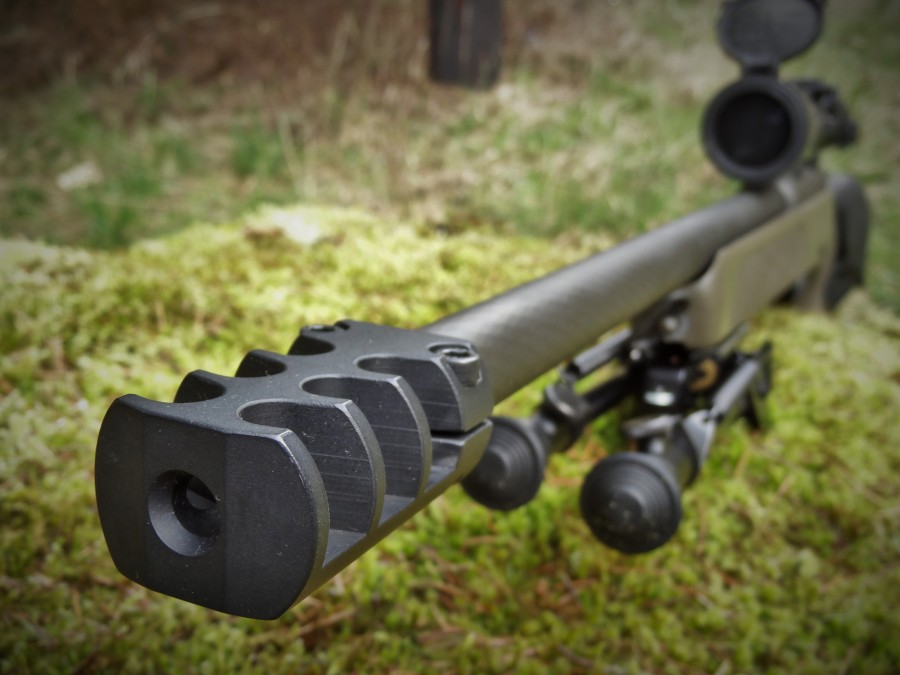
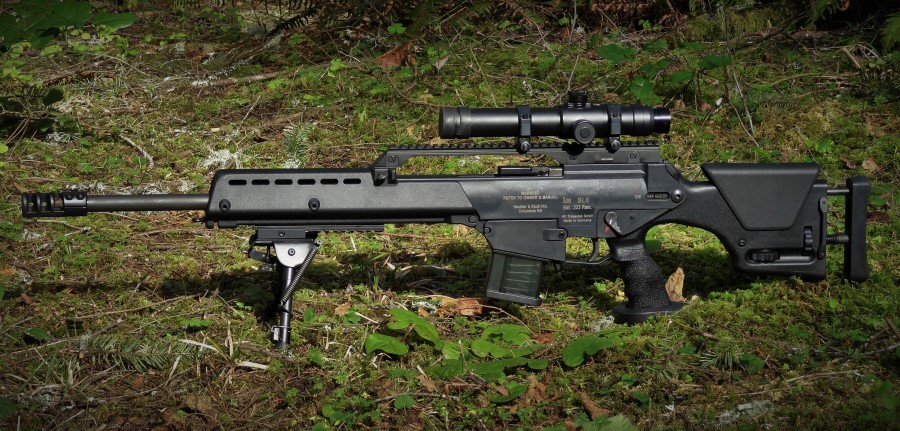
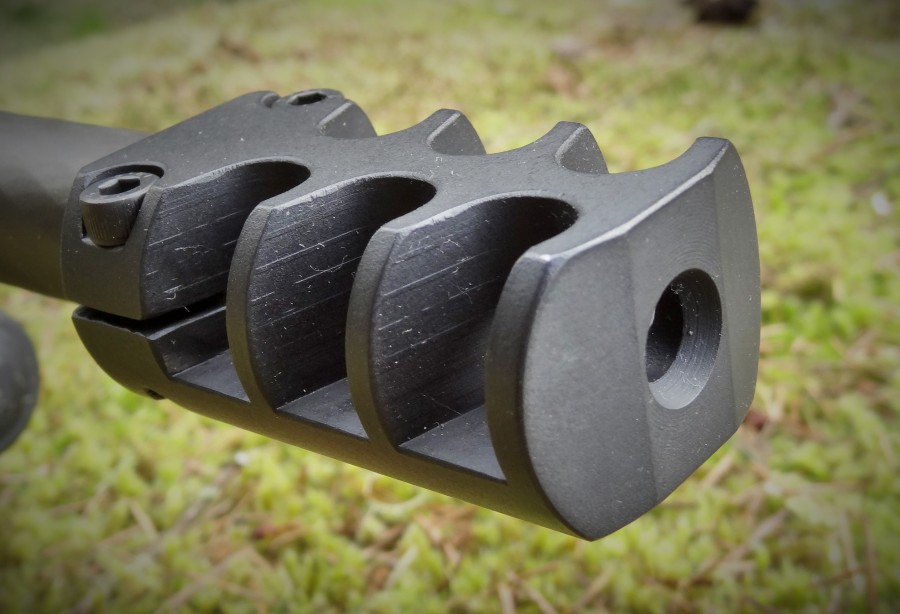

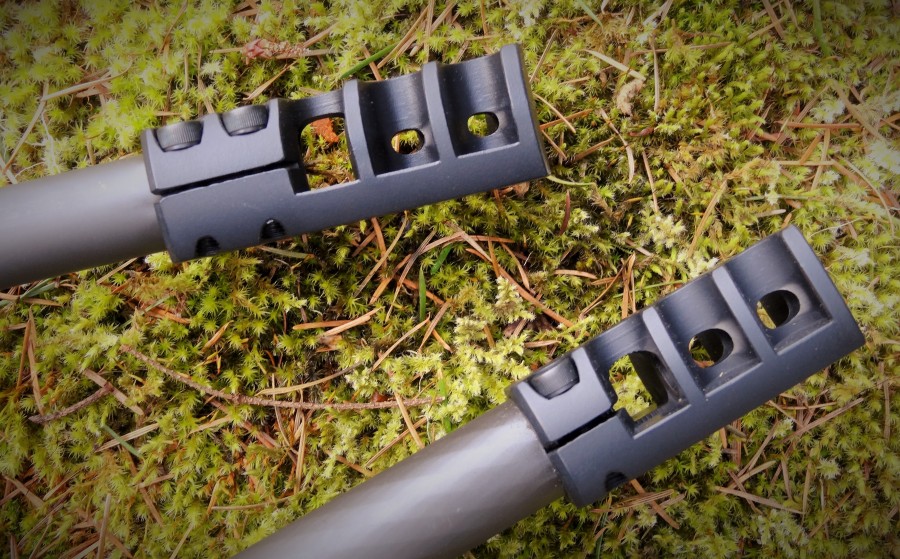
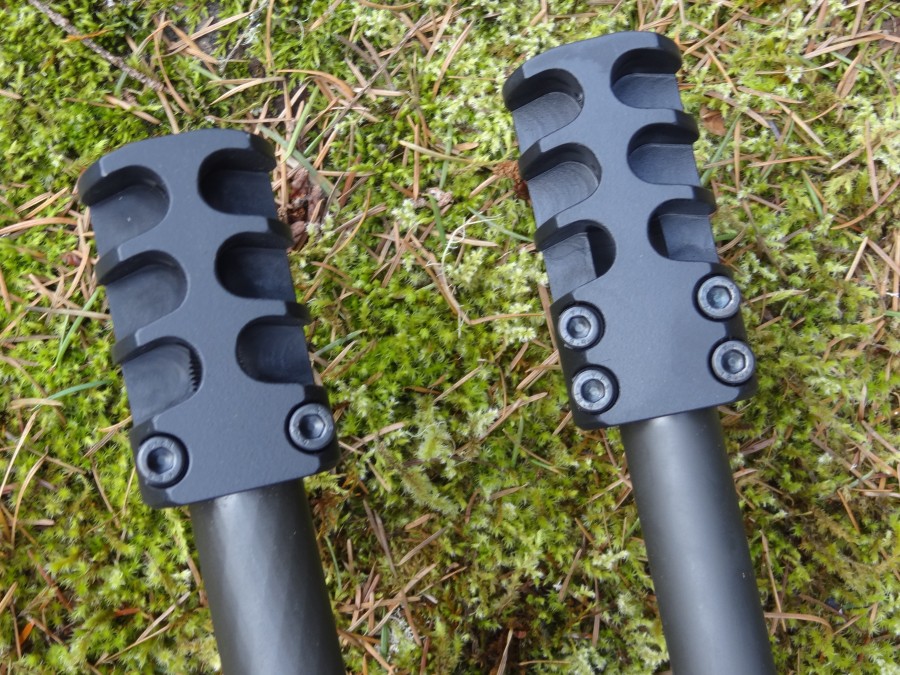
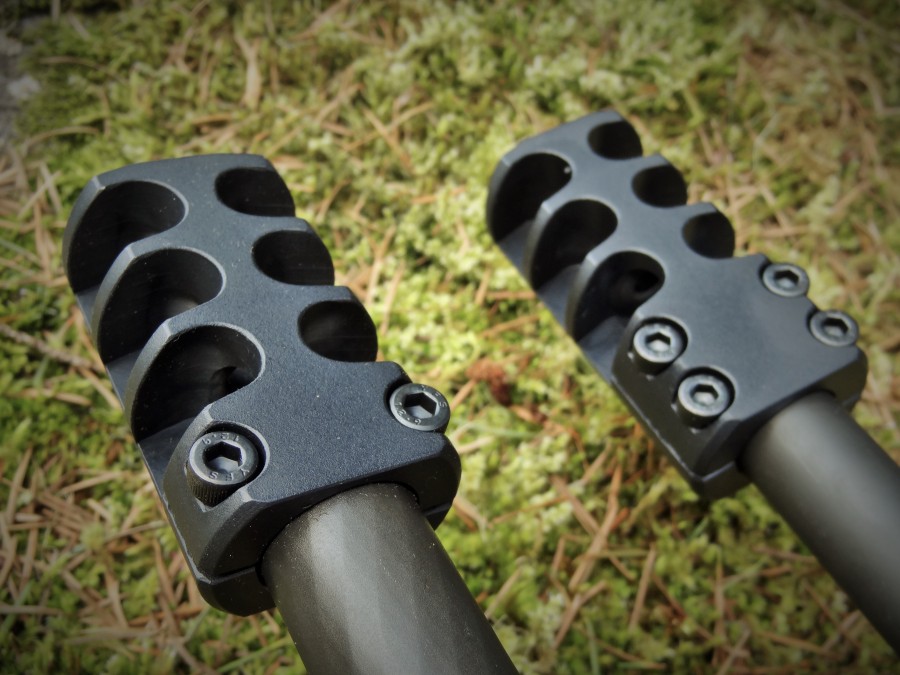
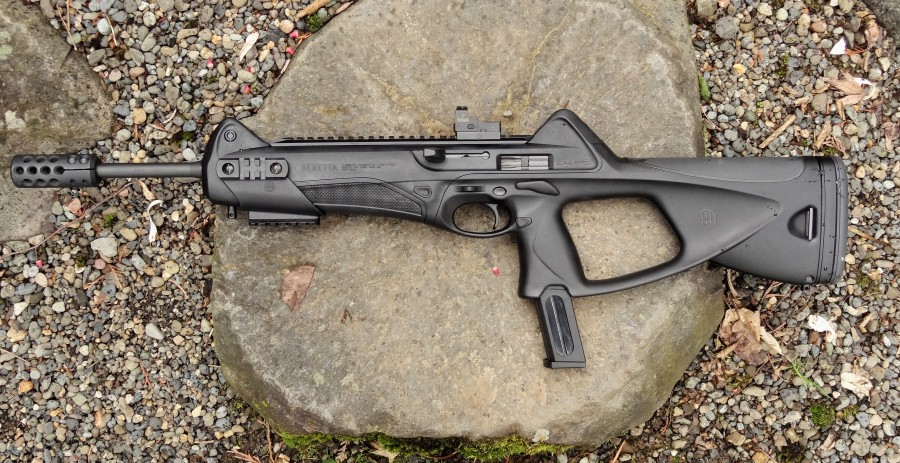
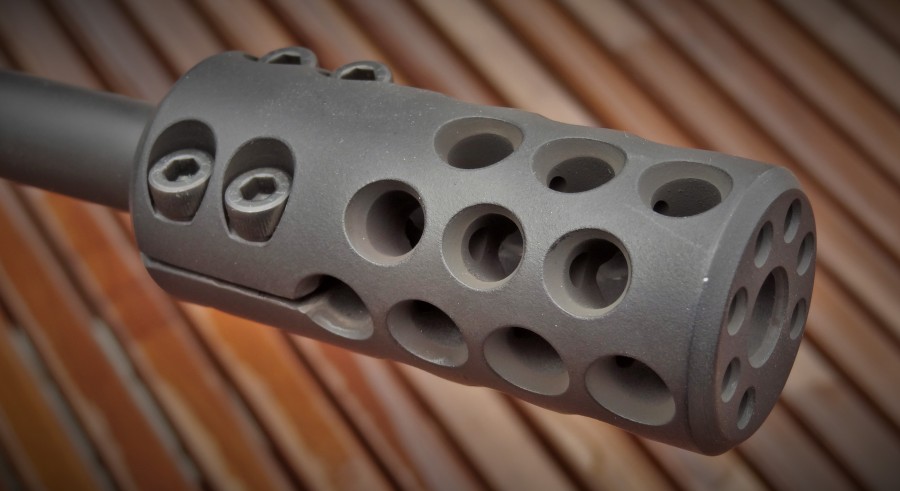
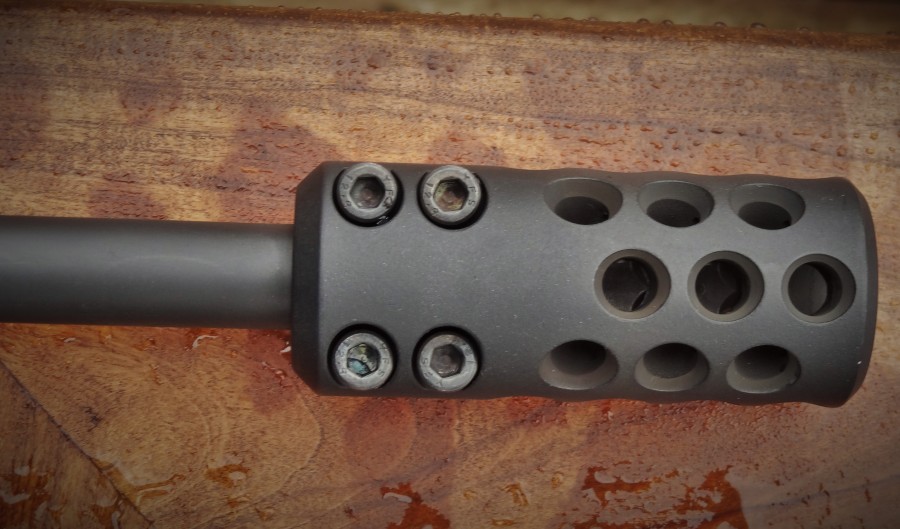
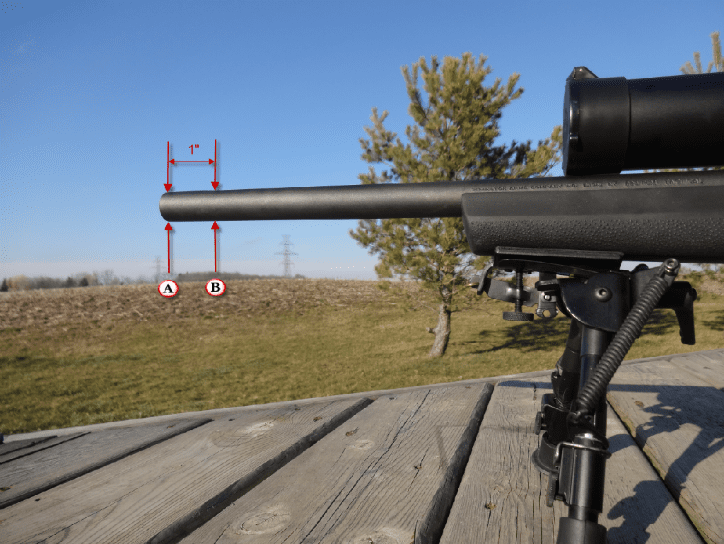
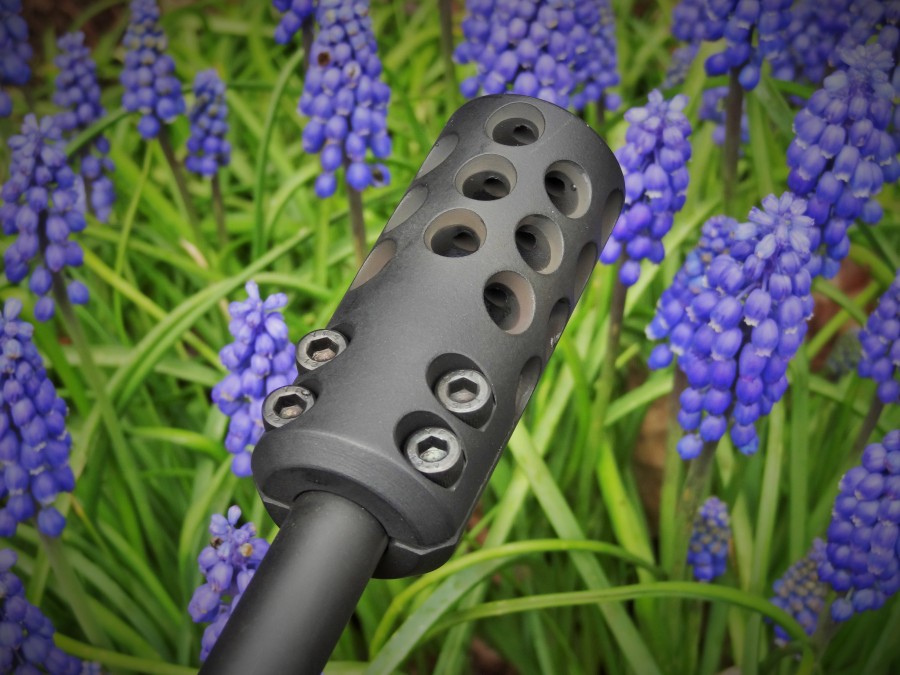



Ah my old nemesis…Muzzle brakes.
I will admit I never liked them, despised them is more accurate, but these do look really cool. I think I will still stick to suppressors, mainly due to the hearing damage from brakes (a muzzle brake adds about 5-10 db IIRC, plugs and muffs add about 3-5 db protection IIRC)
Note: Please excuse lack of grammar/correct writing. My right hand is pretty kaput at the moment. I sorta just smack my hand on the keyboard.
Lolinski,
Your right hand would be working normally if you had used a muzzle brake!
Soccer accident.
I use almost exclusively suppressors.
Ah, and suppressors reduce recoil even more than muzzle brakes.
Can you do a video of the CX4, firing with and without?
I’m working on a review of the CX4. I’ll try to include some video.
Why did you get the CX4 in 9mm? It is available in .45 ACP and I have to believe that is a serious manstopper.
Ammo cost, pure and simple. 2 bangs for every one in .45 acp.
Probably because the 9mm version is:
1) far cheaper for practice which helps you develop proper shot placement which in turn is WAY more important than the fact that .45 has has a 0.095″ larger bullet diameter
2) the lowest-recoiling version you can buy, which means super fast followup shots and target transitions
3) the caliber that gains the most velocity out of a 16″ barrel compared to .40 and .45 as per testing done by Ballistics By The Inch
4) available in a high-capacity Beretta 92 magazine setup that comes with 15 rounders, while other mag options like Mec-Gar let you pack 18 rounds in a flush-fit mag. Want more than that? You can get slap a small baseplate extension on the Mec-Gars and get a 20 rounder that barely protrudes from the magwell funnel. That not enough? Grab 30 some Beretta 30-rounders. The .45 version? It only comes in a version that takes 8045 Cougar mags, 8-round capacity. You _can_ get a heavily-modified 8045 magazine from Sierra Papa that gives you 15 rounds of .45 thanks to a monstrous baseplate extension that doubles the length of the mag for the low low price of $145 per mag plus S&H, though!
Seriously guys, can we stop pretending that that a .356 bullet at 1200 fps is a joke while a .451 bullet @920 is Death, Destroyer of Worlds? At this point there’s been tons of empirical tests which show that unlike centerfire rifle calibers slow fat pistol rounds just poke holes through bad guys and if the hole is poked through something vital it will stop them, if it isn’t it won’t.
“B-b-but what about the difference in muzzle energy???” … is what people who don’t understand what the scientific concept of energy like to say, but it’s pretty pointless to try to bring this up. Kinetic energy isn’t killing magic, it’s basically a semi-abstract concept of the amount of work required to accelerate a given mass to a given velocity. What really matters in terminal ballistics is penetration and permanent cavity size, which is actually very similar in soft tissue between most defensive rounds these days.
Projectiledysfunction,
I am fully on board with the fact that pistol calibers (whether shot out of a handgun or a carbine) do not produce the terminal ballistic effects of rifles.
The primary advantage of .40 S&W and .45 ACP over 9mm is mass which is critical for maintaining velocity at long ranges like 100 yards … beyond practical for a pistol but tenable for a carbine. However, I would NOT like being constrained to only 8 round magazines in a CX4 Storm.
I prefer carbines in .40 S&W. A 180 grain bullet should still be moving at something like 900 fps at 100 yards when shot out of a carbine. Plus magazines are available with 15, 22, and even 29 round capacity. And these days, bulk .40 S&W ammunition is only slightly more expensive than 9mm.
But but but, energy transfer! BIG BUWWETS!
@projectile: That was about the best handling of a “.45 is bestestest” argument I’ve ever read. Nailed just about every point with a sound argument.
Ah, but mass alone isn’t the only thing that determines long-range performance- if it was then competitors would still be shooting 500gr hard-cast .45-70 instead of HPBT 120gr-130gr bullets out of 6 or 6.5mm calibers. Bullet aerodynamics and cross-sectional density play a big part, too.
According to the real-world data provided at Ballistics By The Inch, the two 180gr .40 loads they tested chronographed an average of 1076 and 1083 at the barrel of a Ruger PC4 16″ pistol caliber carbine. The two 124gr 9mm loads they tested from the 16″ CX-4 (similar to what I run for defensive loads in mine) chronoed at 1254 and 1354 and those weren’t even +P.
Knowing those speeds and assuming Hornady’s listed G1 ballistic coefficient for comomn JHP rounds are correct we’re looking at .165 for a 124gr JHP and .164 for a 180gr JHP.
Plugging those figures and the current atmospheric data for my area into Hornady’s ballistic calculator (50y zero) shows these approximate figures for the two calibers:
9mm, 124gr@1254 fps—> 1047 fps@100y, 5.3″ drop
9mm, 124gr@1354 fps—> 1103 fps@100y, 4.4″ drop
.40, 180gr@1076 fps—> 948 fps@100y, 7.1″ drop
.40, 180gr@1083 fps—> 952 fps@100y, 7″ drop
That means from a carbine at 100y these four rounds are performing fairly similarly to what you’d expect to see at the muzzle of a 4.5″ pistol, as per BBTI’s test data for handguns (~1100 for 9mm and ~975 for .40.)
What THAT tells us is that we can use handgun ballistic tests to get an idea of what a 9mm or .40 carbine would do at range, and for that I headed on over to brassfetcher to check out their very detailed calibrated gel tests. I checked their FBI standard penetration/expansion test and found the closest bullet weights and velocities I could to what I calculated that you’d see at 100y for both 9mm and .40:
-9mm 124gr Golden Saber, average impact velocity 1106 fps: 12.7″ penetration, 0.321″^2 bullet expansion
-.40 180gr Ranger-T, average impact velocity 951 fps: 12.9″ penetration, 0.296″^2 bullet expansion
There’s a couple other brands they tested that would work here as an example but these seemed to be the best middle ground I could find. In both cases you could find other rounds with similar bullet weights that had better expansion or better penetration (but not both.) Keeping with the laws of physics if you increase the frontal area of the round it would, of course, be subject to more drag and thus decelerate more rapidly. Both the rounds above represent a nice balance between expansion and penetration.
In the end what I’m getting from this is that at 100 yards, all things considered, they actually seem very evenly matched and would probably have similar difficulty penetrating hard cover given their near-identical ballistic coefficients and demonstrated penetrating capability. The same shots in the same places on an bad guy would do pretty much the same thing, and for that reason I’m still very happy with the lower cost/recoil and higher mag capacity afforded to me by 9mm. I don’t think .40 is a BAD round, mind you, but it’s also not the quantum leap above 9mm that everyone seems to think it is and has cost/capacity drawbacks in comparison.
Wish I’d gotten one before the new CT ban. I bought the JR Carbine instead, and while it works it is overweight and over-complicated for what it does. The Glock magazine compatibility doesn’t compensate for that.
I didn’t know that. Would you recommend the Sub2k over the JR Carbine overall, price points and plinking as main purposes? As I have one but debated getting a .40 one and have yet to see any of the vaporware that takes a Sig mag. Ever.
Always been a fan of JP Rifle brakes.
The issue with clamp on brakes is just because the OD is round doesn’t mean the bore is centered in that spot. Keep that in mind when selecting brakes.
On most American made rifles this isn’t an issue, but some com-bloc guns need to be double checked. That’s the main reason you don’t see a lot of suppressed AKs and one reason Huntwrtown Arms doesn’t sell an AK omni mount.
The price for both brakes is $190 btw. That really should have been included in the “Cost” section of the breakdown.
Aside from that, good writeup. I have to admit though, I seriously wtf’d over the brake on the CX4. Was the performance increase worth the price there?
Its definitely noticeable – even though the Beretta does not have that much recoil to start with. Whether or not its “worth it” probably depends on your financial priorities. If cash is limited, I would probably first opt for getting the factory Beretta hammer, trigger, and related parts swapped out with some made by Sierra Papa CX4: http://sierrapapacx4.com/
I have a Battlecomp on my Daniel Defense M4 V1 and it really does a good job keeping the muzzle down, permitting very fast follow up shots.
Buy a bag of flour. Now you have “dust” to use in your testing.
I thought about using talc, but I’m sure the folks at the range won’t appreciate it. We should have reliably dry conditions by July, so I can wait.
Vietnam Era H&R full auto M14. That’s all I care to type…
nice to know clamp on brakes exist are are good quality! I’ve been looking for one of these for my PTR-91, was afraid I was gona have to just sell her and buy a threaded barrel version but I won’t have to any more!
Going to look at one of these for a nosing build.
Good stuff, as usual Joe.
Thnx!
Joe, I should mail you the Precision Armament brake off my Mosin for you to comparison test on the Steyr. Same thread size & I have the shim kit so you can clock it right.
What was sound signature like for the ghost protocol; the design looks like it would disperse the gases/noise more uniformly around the brake. Thanks for the review.
I don’t think the Ghost Protocol increased noise much at all, if any. I didn’t test it with a meter or anything, but I did not notice any objectionable sound. That is in stark contrast to the Defcon-1, which really lets you know its out there on the end of the barrel by its signature.
for defcon style, the gas are redirected mostly upwards on both side; so it is going to press down the muzzle if one is hand holding a rifle ?
for hand hold, I mean, not on the bench or bipod,
is the grizzly style better in this situation ?
Hello there
Where to buy the muzzle brake for CX4 Storm 9mm
I live in France
thank you very much
I need a bolt on muzzle break for my 7 mm mag. So my son can shoot it ! How much do y’all charge for one to go on it !! Can her the measurements for ya after I find the cost !
I am in the process of ordering my Grizzly Muzzle brake for my .338 weatherby vanguard S2.
In my research I have read comments regarding the concerns of damage to scopes caused by the installation of muzzle brakes.
I would really appreciate your thoughts regarding reported damage to scopes caused by the installation of muzzle brakes.
What is the cost of the muzzle brakes for the Beretta cx4 9mm.
I read your Grizzly Gunworks Gear review and ordered a brake based on your positive review. I can’t comment on how well I like the Brake because I have not received my purchase. I am very dissatisfied with the lack of communication I received from Grizzly Gunworks. I sent several messages asking for a estimated ship date but they went unanswered. I was beginning to wonder if I was dealing with a legitimate business so I threatened to dispute the charge to my Credit Card and finally got a reply. I have to say this is the worst online shopping experience I’ve had in my 26 years of online shopping. If I ever get my Brake I will be happy to update my comment.
I finally received the Brake after I had disputed the purchase and received the refund. I immediately sent a message to Grizzly Gunworks and informed them I received the Brake and I will be happy to return the Brake when they send a return label. I never heard a word from them and it’s still in the box.
Placed an order on Sept 5th still no tracking number I think these guys just collect money I’ve not had a response back after multiple attempts threw e-mails Instagram fb…zero customer service and no phone number to contact I’d sure buy some where else I’m contacting my credit card company and reporting them as frauds 👍
Comments are closed.